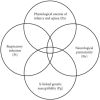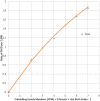An Acute Respiratory Infection of a Physiologically Anemic Infant is a More Likely Cause of SIDS than Neurological Prematurity
- PMID: 27602017
- PMCID: PMC4993813
- DOI: 10.3389/fneur.2016.00129
An Acute Respiratory Infection of a Physiologically Anemic Infant is a More Likely Cause of SIDS than Neurological Prematurity
Abstract
Introduction: The cause of the sudden infant death syndrome (SIDS) is perhaps the oldest of unsolved mysteries of medicine, possibly dating back to Exodus in Biblical times when Egyptian children died in their sleep as if from a plague. It occurs when infants die unexpectedly with no sufficient cause of death found in a forensic autopsy, including death scene investigation and review of medical history. That SIDS is an X-linked recessive death from infectious respiratory disease of a physiologically anemic infant and not a simple anomalous cardiac or neurological condition is an extraordinary claim that requires extraordinary evidence. If it were by a simple cause, it would have already been solved, with over 11,000 papers on SIDS listed now in PubMed. Our aim is to use mathematical models of SIDS to explain: (1) its 50% excess male death rate; (2) its 4-parameter lognormal distribution of ages at death; (3) its winter maxima and summer minima; and (4) its increasing rate with live-birth order.
Methods: From extensive SIDS vital statistics data and published epidemiologic studies, we developed probability models to explain the mathematical behavior of SIDS meeting the four constraints mentioned above. We, then, compare these SIDS properties to infant death from acute respiratory infection (ARI), and infant death from encephalopathy, unspecified (EU).
Results: Comparisons show that SIDS are congruent with ARI and are not consistent with EU and that these probability models not only fit the SIDS data but they also predict and fit the male fraction of all infant and child mortality from birth through the first 5 years of their life.
Conclusion: SIDS are not rejected as an X-linked disease involving ARI and are not explained by a triple risk model that has been commonly accepted by the SIDS medical community, as implicating a neurological causation process in a subset of SIDS.
Keywords: 4-parameter lognormal distribution; SIDS; X-linkage; acute respiratory infections; live-birth order; physiologcal anemia.
Figures








Similar articles
-
Sudden Infant Death Syndrome: Definitions.In: Duncan JR, Byard RW, editors. SIDS Sudden Infant and Early Childhood Death: The Past, the Present and the Future. Adelaide (AU): University of Adelaide Press; 2018 May. Chapter 1. In: Duncan JR, Byard RW, editors. SIDS Sudden Infant and Early Childhood Death: The Past, the Present and the Future. Adelaide (AU): University of Adelaide Press; 2018 May. Chapter 1. PMID: 30035958 Free Books & Documents. Review.
-
The triple risk hypotheses in sudden infant death syndrome.Pediatrics. 2002 Nov;110(5):e64. doi: 10.1542/peds.110.5.e64. Pediatrics. 2002. PMID: 12415070 Review.
-
A controlled study of the relationship between Bordetella pertussis infections and sudden unexpected deaths among German infants.Pediatrics. 2004 Jul;114(1):e9-15. doi: 10.1542/peds.114.1.e9. Pediatrics. 2004. PMID: 15231967
-
Neonatal Monitoring: Prediction of Autonomic Regulation at 1 Month from Newborn Assessments.In: Duncan JR, Byard RW, editors. SIDS Sudden Infant and Early Childhood Death: The Past, the Present and the Future. Adelaide (AU): University of Adelaide Press; 2018 May. Chapter 21. In: Duncan JR, Byard RW, editors. SIDS Sudden Infant and Early Childhood Death: The Past, the Present and the Future. Adelaide (AU): University of Adelaide Press; 2018 May. Chapter 21. PMID: 30035942 Free Books & Documents. Review.
-
Epidemiology of SIDS and explained sudden infant deaths. CESDI SUDI Research Group.Pediatrics. 1999 Oct;104(4):e43. doi: 10.1542/peds.104.4.e43. Pediatrics. 1999. PMID: 10506268
Cited by
-
Distinct Populations of Sudden Unexpected Infant Death Based on Age.Pediatrics. 2020 Jan;145(1):e20191637. doi: 10.1542/peds.2019-1637. Epub 2019 Dec 9. Pediatrics. 2020. PMID: 31818863 Free PMC article.
-
Development of a Risk Score to Predict Sudden Infant Death Syndrome.Int J Environ Res Public Health. 2022 Aug 18;19(16):10270. doi: 10.3390/ijerph191610270. Int J Environ Res Public Health. 2022. PMID: 36011906 Free PMC article.
-
Neonatal circumcision and prematurity are associated with sudden infant death syndrome (SIDS).J Clin Transl Res. 2019 Jan 9;4(2):136-151. eCollection 2019 Jan 10. J Clin Transl Res. 2019. PMID: 30873502 Free PMC article.
-
Mortality Associated With Acute Respiratory Infections Among Children at Home.J Infect Dis. 2019 Jan 9;219(3):358-364. doi: 10.1093/infdis/jiy517. J Infect Dis. 2019. PMID: 30165655 Free PMC article.
References
-
- Guntheroth WG. Crib Death: The Sudden Infant Death Syndrome. 3rd revised ed Armonk: Futura; (1995). 99 p.
-
- Mage DT. A probability model for the age distribution of SIDS. J Sudden Infant Death Syndr Infant Mortal (1996) 1(1):13–31.
Grants and funding
LinkOut - more resources
Full Text Sources
Other Literature Sources

